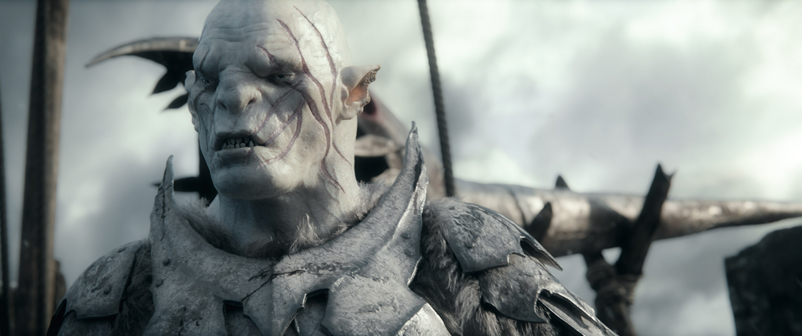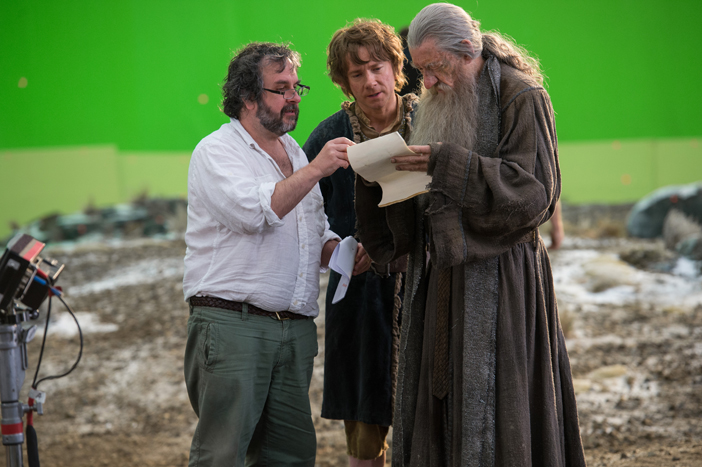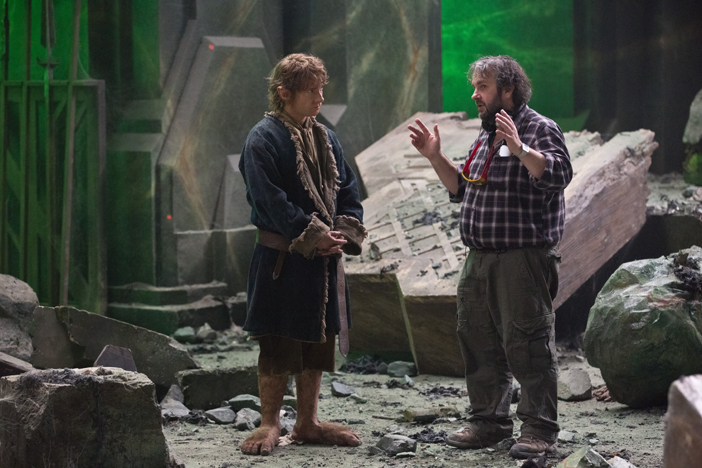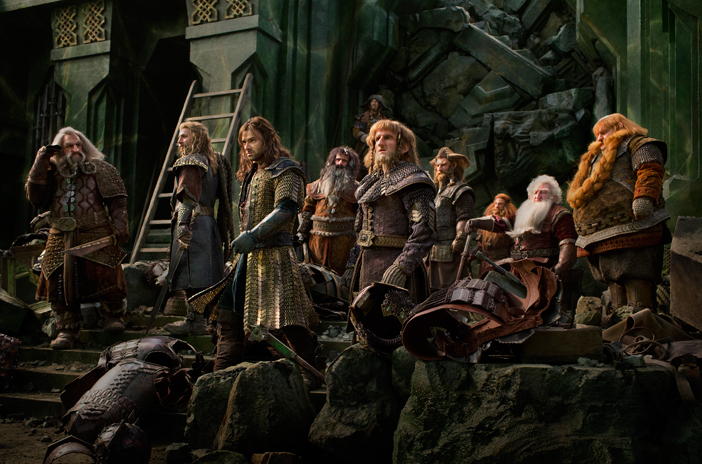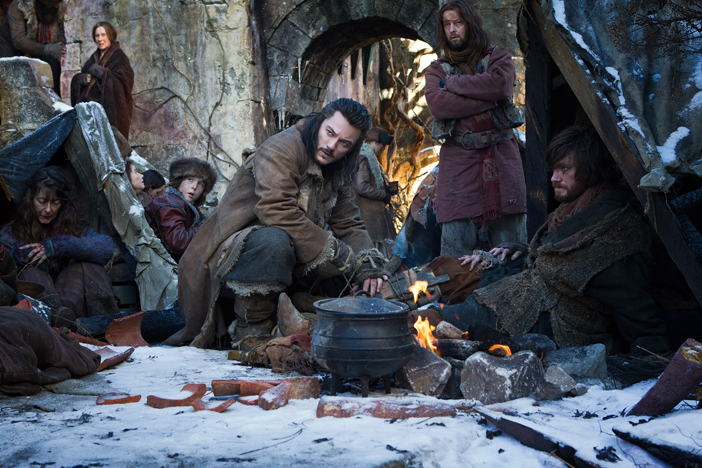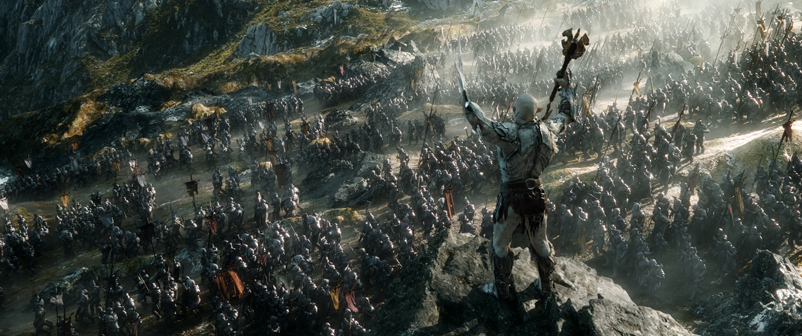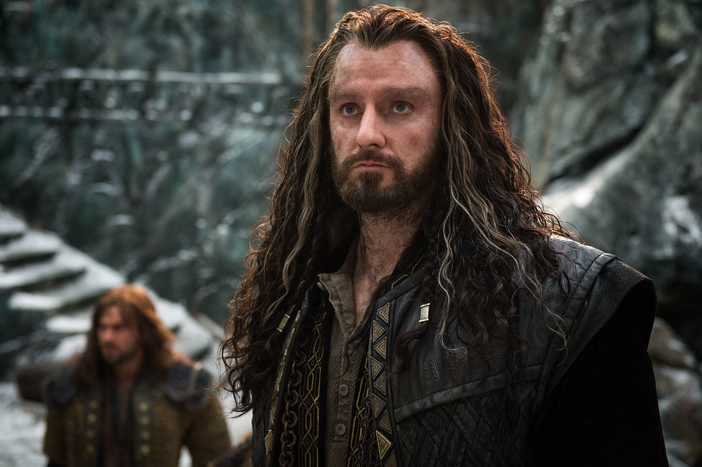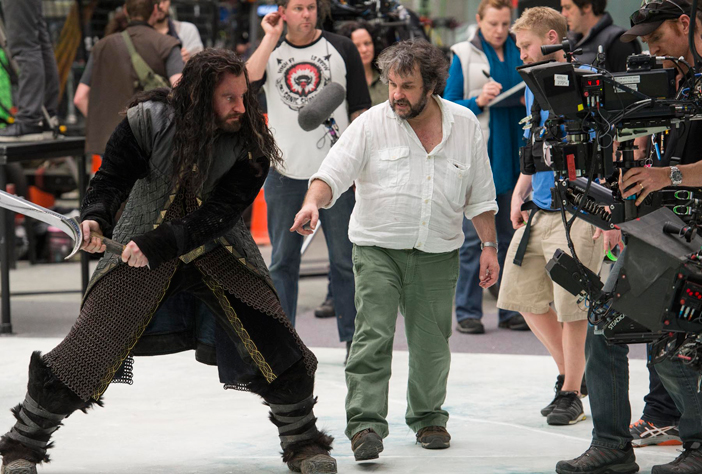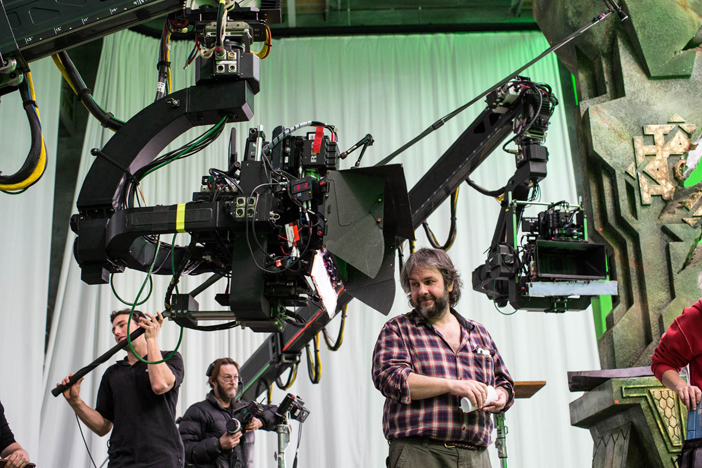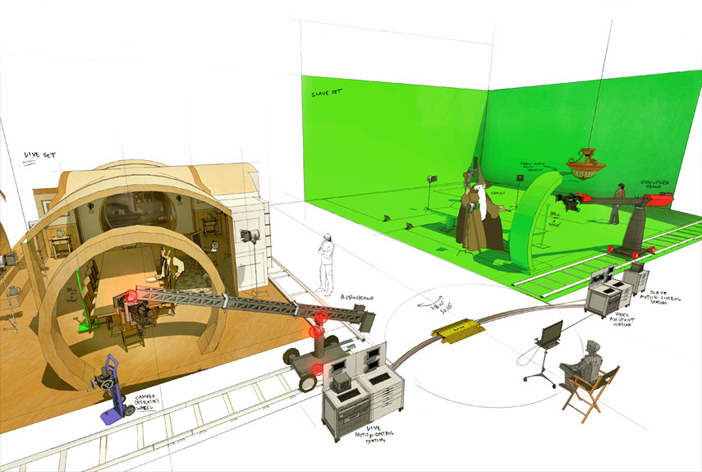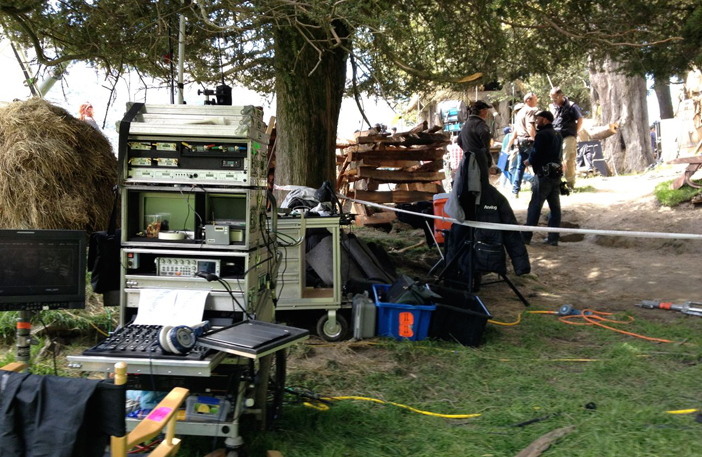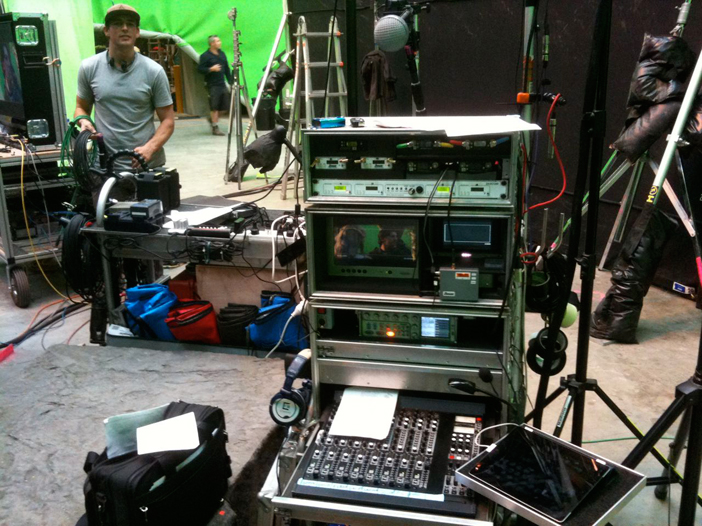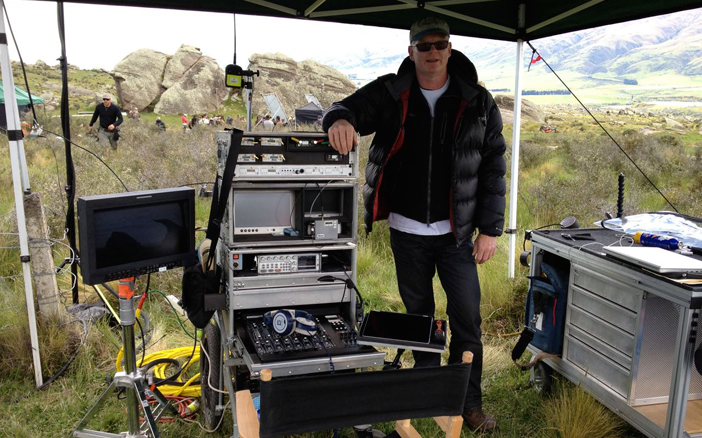
Tony Johnson, in New Zealand on the set of The Hobbit
If you were a production sound mixer, what if we told you there was a job where you had to live in New Zealand and listen to dwarves, wizards, a hobbit, and other mythical creatures on headphones for a year? Oh, and Peter Jackson is directing. Would you do it? Yeah, it seems like an easy answer, and thankfully one Tony Johnson, CAS was able to say yes to.
If you’re unfamiliar with Johnson’s name, he’s been a sound recordist since the 1980s, tracking films like The Piano, the first Chronicles of Narnia, and James Cameron’s Avatar. Before getting the call to be part of all three The Hobbit films, he even mixed Jackson’s Dead Alive – a must-see for any horror fan. “You don’t often get the opportunity to work on something of this scale with someone like Peter,” says Johnson. “He co-writes the script, conceives the whole thing, and then follows through being very hands on. He’s a true artist. Like Cameron, they grab their ideas tightly and run with them. They don’t get tired of it, and they’re extremely focused. It’s wonderful experience.”
Before wrapping up and returning home, Johnson went on his own epic journey, shooting over 260 production days with eleven weeks of reshoots for the three The Hobbit films – The Unexpected Journey, The Desolation of Smaug, and The Battle of the Five Armies. “Post sound is a big influence on Peter’s films, and they basically had say in if I had the job or not,” admits Johnson. “Historically, they were doing a lot of ADR because Peter’s style of shooting isn’t normally conducive to getting good production sound. Plus there tends to be wind machines on most exterior sets. With that said, it’s vital to have the mics as close to the actor’s mouth as possible, so we went down the wireless route pretty quickly.” Johnson was already a Zaxcom Fusion 10 user and was keen on their digital wireless system and thought to use ZaxNet for the entire trilogy. “Supervising dialogue editor Chris Ward was also following the Zaxcom story so there was no convincing needed,” says Johnson.
Each film created its own set of challenges, but Johnson and his two boom operators, Corrin Ellingford and Steven Harris, consistently took the time to wire all the actors each day. The team used Zaxcom TRX900 transmitters in combination with Countryman B6s, DPA 4063s, and the occasional Sanken COS-11D for lavs depending on the application or actor. For the hobbit Bilbo (Martin Freeman), two lavs were needed at times. “Bilbo had this jacket he wore with lapels on it. What we did was put two wireless lavs, one on each side of his lapels, being Countrymen B6’s. They were placed at identical heights and levels so no matter which way he would swivel his head, the audio would match,” explains Johnson. “It was the first time I used two mics on an actor and it worked very well.” For the fourteen different dwarves, they used little hair clips to hide B6s into their beards. And in the case of Gandalf (Ian McKellen), sound hid a TRX900 with a B6 into the cone of his hat. “That saved so much production sound because it was like having a boom a few inches away from his mouth,” notes Johnson.
Besides their collaboration with wardrobe to find the best transmitter positions, with additional support from 2nd unit production mixer Chris Hiles, the sound team was able to take wiring one step further. “Chris used Zaxcom as well, which allowed us to leave the lavs in costumes, so when characters went from set to set, the interchange was seamless,” says Johnson. “We were also getting the additional benefit of having matching metadata over the run of the films for post.”
What also helped production sound was the TRX900’s ability to record internally via microSD card and ZaxNet. What’s nice about ZaxNet is that it gives recordists the capacity to control any Zaxcom TRX wireless remotely, so they don’t have to approach the talent to change the frequency, output power, or pre-amp gain. It even allows the user to put the built-in recorder in record, stop, or playback modes. Johnson had an intricate Zaxcom setup for The Hobbit. On hand he used two Fusion 12s, one Fusion 10, a Mix-12, a Mix-8, eleven TRX900s, twelve ERXTCDs, three IFB100s, and a TRX942 and TRX732 for wireless boom. “The internal recordings proved invaluable,” adds Johnson. “Not just for the occasional range issue, but because I was using my Sonosax SX-ST8 mixer, I could set the trim on the TRX lower, but boost it on my mixer. This way we could have another version, say 10db lower, if we were unsure how the scene would play out. These days on movies, I find we rehearse less and the actors like to give a range of performances in the same take. When we’re doing those ‘rolling resets’ that means we don’t cut between takes, so there’s no opportunity to tweak levels between performance passes. Having the internal recordings and being able to adjust the trims on the transmitters remotely was the difference between keeping production usable, or not.”
For some scenes, Jackson would start shooting with two cameras on Technocranes moving from a wide shot inward. “Peter worked very organically. He liked to keep it that way, so we would have to pay attention to the type of coverage that was taking place,” says Johnson. “We’d watch to see how the scene played out to get a feel for it as it develops. This way we knew what mics would work and where you’d have to go to get something on a boom.” For overhead mics, the Schoeps CMIT-5U and CMC 6/MK 41 were used along with the Sennheiser MKH 40, MKH 50, and MKH 60. Johnson deferred to Ellingford on set, who’s done all of Jackson’s films except The Lovely Bones. “Corrin runs the set and he feeds me all the info of what’s going on. He’s a wizard in his own right and we would use a private line to constantly communicate, like if I needed to tell them if a second camera was moving in for a close-up,” says Johnson.
As for the motion capture sequences, Johnson happily admitted they were a sound mixer’s dream. “You can basically place the mic anywhere you want. With a boom running, we also had a DPA taped to the capture arm above their head allowing me to listen to rich, beautiful dialogue all day. Mocap was a newer experience and something I can easily get used to,” laughs Johnson.
Sound’s more challenging days came when Jackson worked with the slave motion control system. It’s a complex setup that allows characters of different sizes to do a scene together at the same time. It was used when a character like Gandalf had to talk to the dwarves or Bilbo. What happens is two adjoining sets are constructed – a fully dressed set and the other a green screen. The master rig is outfitted with encoders that measure the pan, tilt, and motion of the camera dolly underneath. The data is then crunched through software and is instantly relayed to the slave rig on the green screen set, allowing Jackson to see the results of the scene instantly. In order to achieve realism in the scene, the actors had to work off dialogue cues by wearing earwigs, because they couldn’t see each other. “The whole thing was driven by sound. If we messed up or they couldn’t hear the cue to know where to move on set or what their eyeline was, it wouldn’t work…this did happen,” says Johnson.
The workflow between production and post on The Hobbit was quite impressive. Besides the mix, Johnson would have all the actors on ISO tracks, plus the TRX900s recording internally onto microSDs. At the end of the day, every track, including the internal recordings, was backed up onto a hard drive and delivered to post. What made The Hobbit such a unique experience for Johnson was that post listened to all the files, both those coming from his Fusion recorders and the TRX900s. “They had several people listening to the recordings to see what sounded better,” explains Johnson. “On some films, you don’t know if the people in post are even reading your production notes of what track to use, but on The Hobbit, we were all talking the same language. They would cut and paste the best audio together using the booms, ISOs, or the audio from the internal recorders. We would email daily and I kept in touch with dialogue rerecording mixer Mike Hedges who said they ended up using approximately 85% of the production sound on The Battle of the Five Armies, which was very high.”
Besides the emails, what proved to be useful for Johnson was how logistically close post was to production. “You’re only like a few minutes’ drive away, so I could do a scene on a Monday and if I was worried about any production issues, like a wind machine, I could go there and they would show me what they could do to get rid of it,” mentions Johnson. “What post was able to do using the RX3 software from iZotope was incredible. They would show me the original recordings and then the noise reduction and EQ passes, and you could hear the noise disappear.”
One of those learning moments with post for Johnson was working with the set’s HMI lights. “Because we were shooting at 48fps, the HMI lights had to be on flicker free. Anytime we shot with them, which was a lot, they had a high-pitch squeal to them. In order to get rid of some of it, we had to baffle around the heads with noise reduction material and furniture removal blankets. Working with post over the course of the three movies, I knew exactly how much noise I would get away with without affecting the dialogue. We had a good relationship, but it was important for us to capture a quality signal for them to start with.”
For The Battle of the Five Armies, the story picks up where The Desolation of Smaug left off, so it may be wise to refresh your memory before viewing. In the story, the goblins and the Wargs wage war against the men of Dale, elves, dwarves and the fashionably late Eagles of the Misty Mountains. As in the first two films, one piece of gear that proved to be precious was the Zaxcom ERXTCD. “Peter directed from a tent with large 3D monitors and a voice-of-god (VOG) for communications. Of course, he was listening to the production sound sourced from video village so it had a delay,” says Johnson. “This would normally make it difficult for him to use the VOG as he would hear himself delayed, so we gave him an ERXTCD with a pair of Bose noise-cancelling headphones. It meant he could communicate with the VOG and hear the actors on their lavs and have a very good quality IFB to listen to while cancelling out extraneous set noise. It also allowed Peter to make critical sound decisions because of the quality of the IFB.”
On location, Johnson used a 30° 14db gain aerial on their L-com RF amp for the IFB 100 to get the range they required, because at times they were far from the action. “We also used Zaxcom’s Voting System on many occasions with the spare IFB100 – that worked great. Another thing we used was the alternate channel in the ERXTCD, so Corrin and Steve could easily switch to Peter’s channel to make sure everything was OK,” Johnson explains.
A scene where the sound team wasn’t too close to the action was a fight scene between Thorin (Richard Armitage) and Azog (Manu Bennett), the leader of the goblins. The sequence plays out over a vast, frozen lake, and by the end Bilbo walks over to Thorin. During the shooting of this sequence, Johnson made it a point to ask Jackson to consider production sound. “Peter is very technically savvy, it’s one of the great things about him, and we’re here to help his vision along the way. Ultimately he makes all the decisions, but there were a few times I suggested turning off a wind machine if the scene was emotional – this was one of those moments. There were about two handfuls of times we’d ask for a specific thing for Peter to consider. He always would and that’s how our relationship developed over the films. It wasn’t about verbalizing all the time, but allowing him to see the work we were doing to build his trust in us.”
Looking back, one of Johnson’s favorite memories was a vast location trip in New Zealand. “It was the most amazing orchestration I’ve ever seen. Over 200 vehicle movements per day, and we were filming in tiny towns that were able to accommodate 600 cast and crew. It was done with such military precision and everyone was smiling. It’s a real family feel down here in Wellington. Everyone was so generous and able to do their best work – I can’t think of one bad day. It was an extraordinary experience to be part of, and it was great having Corrin and Steven along for the ride.”
(via Sound & Picture)

